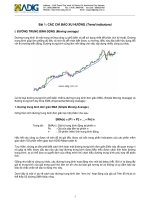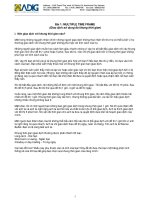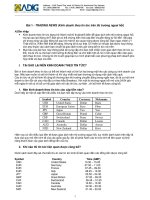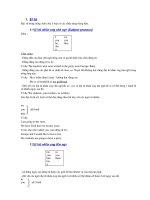Giáo trình Rhino phần 1
Bạn đang xem bản rút gọn của tài liệu. Xem và tải ngay bản đầy đủ của tài liệu tại đây (5.58 MB, 268 trang )
R40TML1-09-2006
Rhino
ceros
®
NURBS modeling for Windows
Training Manual
Level 1
Version 4.0
Robert McNeel & Associates ii
Rhinoceros Level 1 Training Manual v4.0
© Robert McNeel & Associates 2006
All Rights Reserved.
Printed in U.S.A.
Copyright © by Robert McNeel & Associates. Permission to make digital or hard copies of part or all of this work for personal or classroom use is granted
without fee provided that copies are not made or distributed for profit or commercial advantage. To copy otherwise, to republish, to post on servers, or to
redistribute to lists requires prior specific permission. Request permission to republish from: Publications, Robert McNeel & Associates, 3670 Woodland Park
Avenue North, Seattle, WA 98103; FAX ( 206 ) 545-7321; e-mail
TABLE OF CONTENTS
Robert McNeel & Associates iii
Table of Contents
List of Exercises v
Part One: Introduction 1
Before You Start 1
Course Objectives 1
Rhino Basics 3
The Rhino for Windows Interface 3
The Rhino Screen 4
Menus 5
Toolbars 5
Graphics Area 6
Command Area 9
The Mouse 9
Entering Commands 9
Help 11
View the Command Line History 12
View Recent Commands 12
Navigating Around the Model 18
Move Objects 19
Copy Objects 20
Changing the View of Your Model 22
Panning and Zooming 22
Resetting Your View 23
Part Two: Creating Geometry 29
Creating Two-Dimensional Objects 31
Drawing Lines 31
Drawing Free-form Curves 33
Modeling Aids 34
Model Setup 36
Saving Your Work 38
Layers 38
Deleting Objects 42
Precision Modeling 47
Absolute Coordinates 47
Relative Coordinates 48
Polar Coordinates 49
Distance and Angle Constraint Entry 50
Viewports 53
Object Snaps 59
Analysis Commands 62
Drawing Circles 64
Drawing Arcs 71
Drawing Ellipses and Polygons 76
Modeling Helix and Spiral 85
Editing Objects 89
Fillet 89
Chamfer 94
Move 99
Copy 100
Undo and Redo 102
Rotate 102
Group 103
Mirror 104
Join 105
Scale 105
Array 108
Trim 112
Split 114
Extend 115
Offset 118
Point Editing 129
Nudge Controls 134
TABLE OF CONTENTS
Robert McNeel & Associates iv
Part Three: 3-D Modeling and Editing 139
Creating Deformable Shapes 141
Modeling with Solids 157
Creating Surfaces 167
Importing and Exporting Models 221
Importing and Exporting Rhino File Information 221
Rendering 225
Rendering with Flamingo 233
Dimensions 237
Dimensions 237
Making a 2-D Drawing from a 3-D Model 240
Printing 243
Part Four: Customizing Workspaces and Toolbars 247
Rhino Settings 249
Options 249
Document Properties 253
Custom Toolbar Layouts 255
LIST OF EXERCISES
Robert McNeel & Associates v
List of Exercises
Exercise 1—Rhino basics 13
Exercise 2—Display options 24
Exercise 3—Drawing lines 31
Exercise 4—Drawing interpolated curves 34
Exercise 5—Drawing curves from control points 34
Exercise 6—Drawing lines and curves using mode functions 35
Exercise 7—Layers 39
Exercise 8—Selecting objects 40
Exercise 9—Practice using delete and selection options 42
Exercise 10⎯Setting up a model 47
Exercise 11—Entering absolute coordinates 48
Exercise 12—Entering relative coordinates 48
Exercise 13—Entering polar coordinates 49
Exercise 14—Distance constraint entry 50
Exercise 15—Distance and angle constraint entry 51
Exercise 16—Practice using distance and angle constraint entry 52
Exercise 17—Modeling in 3-D space 55
Exercise 18—Practice using distance and angle constraints 58
Exercise 19—Using object snaps 60
Exercise 20—Drawing circles 65
Exercise 21—Practice drawing circles 67
Exercise 22—Using circle-related object snaps 69
Exercise 23—Practice drawing arcs (1) 72
Exercise 24—Practice drawing arcs (2) 75
Exercise 25—Practice drawing ellipses and polygons 78
Exercise 26—Drawing free-form curves 87
Exercise 27—Fillet 89
Exercise 28—Chamfer 94
Exercise 29—Practice with Fillet and Chamfer 97
Exercise 30—Move 99
Exercise 31—Copy 101
Exercise 32—Rotate 102
Exercise 33—Grouping 103
Exercise 34—Mirror 104
Exercise 35—Join 105
Exercise 36—Scale 105
Exercise 37—Array 108
Exercise 38—Trim 112
Exercise 39—Split 114
Exercise 40—Extend 115
Exercise 41—Offset 118
Exercise 42—Practice 124
Exercise 43—Practice 125
Exercise 44—Practice 126
Exercise 45—Practice 127
Exercise 46—Control point editing 130
Exercise 47—Practice with curves and control point editing 136
Exercise 48—Creating a rubber duck 142
Exercise 49— Model a bar with text 158
Exercise 50—Basic techniques for making surfaces 168
Exercise 51—Extruding surfaces 171
Exercise 52—Lofted surfaces 179
Exercise 53—Revolved surfaces 184
Exercise 54—Using a rail revolve 185
Exercise 55—Using 1-rail sweeps to create surfaces 186
Exercise 56—Using 2-rail sweeps to create surfaces 188
Exercise 57—Using a network of curves to create surfaces 191
Exercise 58— Practice using one-rail sweeps: 192
Exercise 59— Creating a toy hammer: 195
Exercise 60— Creating a squeeze bottle: 207
Exercise 61— Exporting models 221
Exercise 62— Practice rendering a model 225
Exercise 63— Practice dimensioning 239
Exercise 64— Practice making a 2-D drawing for export 240
Exercise 65— Practice printing 243
Exercise 66— Practice with options 249
Exercise 67— Practice with document properties 253
Exercise 68— Customizing a toolbar layout 255
LIST OF EXERCISES
Robert McNeel & Associates vi
Part One:
Introduction
Notes:
Robert McNeel & Associates 1
1
1
1
Before You Start
This course guide accompanies the Level 1 training sessions. Level 1 shows you how to produce 3-D models using
NURBS geometry.
In class, you will receive information at an accelerated pace. For best results, practice at a Rhino workstation
between class sessions, and consult your Rhino reference manual and the Help file for additional information.
Duration:
3 days
Course Objectives
In Level 1, you learn how to:
• Utilize the features of the Rhino user interface
• Customize your modeling environment
• Create basic graphic objects—lines, circles, arcs, curves, solids, and surfaces
• Model with precision using coordinate input, object snaps, and SmartTrack tools
• Modify curves and surfaces with edit commands
• Use control point editing to modify curves and surfaces
• Analyze your model
• Display any portion of the model
• Export and import models to and from different file formats
• Render the model
The Rhino for Windows Interface
Rhino uses NURBS for all curve
and surface geometry.
Notes:
Robert McNeel & Associates 3
2
2
2
Rhino Basics
The Rhino for Windows Interface
Before learning individual tools, we will get acquainted with the Rhino interface. The following exercises examine
the interface elements used in Rhino: the Rhino window, viewports, menus, toolbars, and dialog boxes.
There are many ways to access the commands in Rhino—the keyboard, menus, and toolbars. We will focus on the
menus in this class.
To open Rhino:
Double-click the Rhino icon from the Windows desktop.
Notes:
Robert McNeel & Associates 4
The Rhino Screen
Rhino divides its window into six areas that supply information or prompt you for input.
Screen Area Description
Menu Bar Access commands, options, and help.
Command area Lists prompts, commands you enter, and information displayed by the command.
Toolbars Access shortcuts to commands and options.
Graphics area
Displays the open model. Several viewports can be displayed. The default viewport layout displays four
viewports ( Top, Front, Right, Perspective ).
Viewports Displays different views of the model within the graphics area.
Status bar Displays the coordinates of the pointer, the status of the model, options, and toggles.
Rhino screen
Watch the command line to find
out what is happening.
Menu bar
Command history
window
Command prompt
Standard toolbar
Graphics area
World axes icon
Viewport title
Main1 and Main2
toolbars
Status bar
Notes:
Robert McNeel & Associates 5
Menus
Most of the Rhino commands can be found in the menus.
Rhino View menu
Toolbars
Rhino toolbars contain buttons that provide shortcuts to commands. You can float a toolbar anywhere on the
screen, or dock it at the edge of the graphics area
Rhino starts up with the Standard toolbar docked above the graphics area and the Main1 and Main2 toolbars
docked on the left.
Notes:
Robert McNeel & Associates 6
Tooltips
Tooltips tell what each button does. Move your pointer over a button without
clicking it. A small yellow tag with the name of the command appears. In
Rhino, many buttons can execute two commands. The tooltip indicates which
buttons have dual functions.
To start a Polyline, click the
LMB, to start the Line Segments
command click the RMB.
Flyouts
A button on a toolbar may include other command buttons in a
flyout toolbar. Usually the flyout toolbar contains variations on
the base command. After you select a button on the flyout, the
flyout disappears.
Buttons with flyouts are marked with a small white triangle in
the lower right corner. To open the flyout toolbar, hold down
the left mouse button for a moment or press the right mouse
button.
The Lines toolbar is linked to the Main1 toolbar.
After the flyout is open you can pick any of the
buttons on the toolbar to start a command.
Graphics Area
The Rhino graphics area holding the viewports can be customized to suit your preferences. The position of
viewports can be arranged in different configurations.
Notes:
Robert McNeel & Associates 7
Viewports
Viewports are windows in the graphics area that show you views of your model. To move and resize viewports,
drag the viewport title or borders. You can create new viewports, rename viewports, and use predefined viewport
configurations. Each viewport has its own construction plane that the cursor moves on and a projection mode.
To toggle between a small viewport and one that fills the graphics area, double-click the viewport title.
Rearranged Rhino screen. Command line at the bottom, single maximized viewport, and toolbars
docked in different locations.
Notes:
Robert McNeel & Associates 8
Viewport tabs
Viewport titles can be shown in tabs. The bold face tab designates the active viewport. Tabs make it easy to
switch between viewports when using maximized or floating viewports. To activate Viewport Tabs: From the View
menu, click Viewport Layout, then click Show Viewport Tabs.
The tabs are located below the graphics area.
Notes:
Robert McNeel & Associates 9
Command Area
The command area displays commands and command prompts. It can be docked at the top or the bottom of the
screen or it can float anywhere. The command window shows two lines by default. To open a window that displays
the command history, press F2. The text in the Command History window can be selected and copied to the
Windows clipboard.
The Mouse
In a Rhino viewport, the left mouse button selects objects and picks locations. The right mouse button has several
functions including panning and zooming, popping up a context-sensitive menu, and acting the same as pressing
the Enter key. Use the left mouse button to select objects in the model, commands or options on the menus, and
buttons in the toolbars. Use the right mouse button to complete a command, to move between stages of
commands, and to repeat the previous command. The right mouse button is used to initiate commands from
some toolbar buttons.
Drag with the right mouse button to pan and rotate in viewports. Use the mouse wheel or hold down the Ctrl key
and drag with the right mouse button to zoom in and out in a viewport. You must press and hold the right mouse
button down to activate this feature.
Entering Commands
Use the command line to type commands, pick command options, type coordinates, type distances, angles, or
radii, type shortcuts, and view command prompts.
To enter information typed at the command line, press Enter, Spacebar, or right mouse button over a viewport.
Note: Enter and Spacebar perform the same function.
Shortcuts are customizable key combinations. You can program the function keys and Ctrl key combinations to
perform Rhino commands.
Clickable options
To use command options, click the option on the command line or type the underlined letter of the option and
press Enter. (The interior capitalization is meaningless.)
Notes:
Robert McNeel & Associates 10
Autocomplete command name
Type the first few letters of a command name to activate the autocomplete
command list. When enough letters of the command are typed so that it is
unique, the command name completes on the command line. Press Enter to
activate the command once the full command name appears. As you type
command names, the autocomplete command list appears. As you type more
letters, the list is narrowed down to the possible commands. Left click on the
command in the list to start it.
Repeating commands
To repeat the last command, right-click in a viewport, or press Enter or spacebar. To repeat previous
commands, right-click in the command line window and select from a list.
Canceling commands
To cancel a command, press Esc or enter a new command from a button or a menu.
Notes:
Robert McNeel & Associates 11
Help
Press F1 at any time to access Rhino Help. In addition to finding information about each command, Rhino help
has conceptual information as well as many examples and graphics to help you complete your model. When you
are stalled for any reason, the first place you should look is the help file. You can also access help for a specific
command by starting the command and then press F1.
In addition, the Command Context command displays the help topics in a dockable window and displays help for
the current command.
Most of the commands include short video clips that show how the command and the options work.
If Auto-update is checked, the help for the current command displays. If Auto-update is unchecked,
you can type the name of the command that you want displayed and then press enter to display
the information.
Notes:
Robert McNeel & Associates 12
View the Command Line History
The command history window lists the last 500 command lines from the
current Rhino session. Press F2 to view the command history.
View Recent Commands
Right-click the command line to view recently used commands. To
repeat the command, select it from the popup menu.
The number of commands listed is set in Rhino Options. The default limit
is twenty commands. When you use your twenty-first command the first
one drops off the list.
Notes:
Robert McNeel & Associates 13
Exercise 1—Rhino basics
1 From the File menu, click Open.
2 In the Open dialog box, select First Model.3dm.
You will find this model in the Training folder. If you haven’t copied the files to your hard drive from the
Training folder on the Rhino CD, you should do this before you proceed.
Two parallel viewports and one perspective viewport.
This model contains five objects: a cube, a cone, a cylinder, a sphere, and a rectangular plane.
Open
Notes:
Robert McNeel & Associates 14
3 From the View menu, click Viewport Layout, then click 4 Viewports.
Three parallel viewports and one perspective viewport
4 In the Status Bar, click Snap to turn on the grid snap.
Grid snap may already be on in your system. Be careful that you do not turn it off instead of on. If grid snap
is on, the word “Snap” will be black in the status bar. If it is off, the word “Snap” will be gray.
Note: This is an important step. Grid snap only lets your cursor move in certain intervals. In this model, by
default grid snap is set to one half of a grid line. Grid snap helps you line up your objects as if you were
building with LEGO
®
blocks.
Notes:
Robert McNeel & Associates 15
5 Click the mouse in the Perspective viewport to make it active.
The viewport title highlights when it is active. The active viewport is
the viewport where all your commands and actions take place.
6 Click with the Right Mouse Button (RMB) on the Perspective
viewport title, then click Shaded.
The objects appear shaded. A shaded viewport lets you preview the
shapes. The viewport will remain shaded until you change it back to a
wireframe view. You can change any viewport to shaded mode. Later
we will discuss the other viewport display options.
Shaded display.
7 From the Render menu, click Render.
Rendering the model opens a separate render window. The model
displays in render colors previously assigned to the objects. You can
also set lights and a background color. You will learn about doing this
later. You cannot manipulate the view in the render display window but
the image can be saved to a file.
8 Close the render window.
Render.
Render
Notes:
Robert McNeel & Associates 16
9 In the Perspective viewport, click and drag with your right mouse
button held down to rotate the view.
The plane helps you stay oriented. If the objects disappear, you are
looking at the bottom of the plane.
Rotate the view in shaded display.
10 Right click on the Perspective viewport title, then click Ghosted.
Ghosted shade display.
11 Right click on the Perspective viewport title, then click X-ray.
X-Ray shaded display.
12 Right click on the Perspective viewport title, then click Rendered.
Rendered display.
Notes:
Robert McNeel & Associates 17
13 Change to Wireframe mode.
14 To rotate your view, drag from the bottom of the view toward the top.
You are now under the objects looking up.
Looking at the objects from the
bottom in wireframe mode.
15 Change to Shaded mode.
The plane obscures the objects. In shaded mode, the plane helps you
see when your viewpoint is below the objects.
Looking at the objects from the
bottom in shaded mode.
To get back to your original view:
Press the Home key to undo your view changes.
If you are “lost in space” in the perspective view:
From the View menu, click Viewport Layout, and then click 4 Viewports.
This takes you back to the default viewport settings.
Notes:
Robert McNeel & Associates 18
Navigating Around the Model
You have used the right mouse button to rotate in the Perspective viewport. You can hold Shift and drag with
the right mouse button to pan. Dragging the right mouse button to move around does not interrupt any
commands in progress.
To pan in a viewport:
1 In the Top viewport, drag with the right mouse button to pan the view.
2 Pan the view in the other viewports.
Panning with Shift and the right
mouse button.
Zooming in and out
Sometimes you want to get closer to your objects or move back so you can see more. This is called zooming. As
with many things in Rhino, there are several ways to do this. The easiest way is to turn the mouse wheel to zoom
in and out. If you don’t have a wheel mouse, hold down the Ctrl key and drag up and down in a viewport with
the right mouse button.
To zoom in and out:
1 In the Perspective Viewport, roll the wheel on your mouse forward to
zoom in, roll it backward to zoom out.
The camera zooms at cursor position.
2 In the Perspective viewport, hold the Ctrl key, click and hold the right
mouse button, and drag the mouse up and down.
Drag up to zoom in.
Drag down to zoom out.
Zooming with ctrl and the right
mouse button.
What if …
Instead of panning or rotating,
something funny happened.
If you right-click quickly once in
viewport, the last command
starts again. You must hold the
right mouse button down while
panning or rotating.









